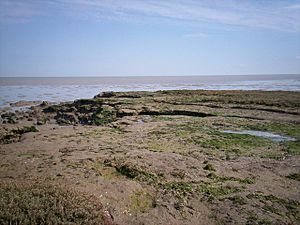Dengie nature reserve facts for kids
| Site of Special Scientific Interest | |

Tillingham Marshes
|
|
| Area of Search | Essex |
|---|---|
| Interest | Biological Geological |
| Area | 3105.0 hectares |
| Notification | 1986 |
| Location map | Magic Map |
|
Designations
|
|
| Official name: Dengie | |
| Designated: | 24 March 1994 |
|---|---|
| Reference #: | 651 |
The Dengie nature reserve is a huge and important natural area in Essex, England. It covers about 3,105 hectares (that's over 7,600 acres!) and sits between the Blackwater and Crouch rivers, near Bradwell-on-Sea.
This special place is important for both its amazing wildlife (biological) and its interesting landforms (geological). It has many different special titles, like being a Site of Special Scientific Interest (SSSI), a National Nature Reserve, and a Ramsar site. These titles mean it's recognized as a really important place for nature, not just in the UK but around the world!
Contents
What Makes Dengie So Special?
Dengie is mostly made up of vast, quiet areas of tidal mud-flats and salt marshes. These are flat, muddy areas along the coast that get covered by the sea at high tide and uncovered at low tide. Salt marshes are grassy areas that grow in salty water. They are found at the eastern end of the Dengie Peninsula.
The ancient Chapel of St Peter-on-the-Wall, a very old church, stands overlooking parts of this reserve. It's a peaceful spot where you can see how nature and history meet.
Why is it a Wetland of International Importance?
Dengie is known as a "wetland of international importance" because it provides a perfect home for many different kinds of birds, especially those that love coastal areas. These birds come here to feed, rest, and raise their young.
Amazing Birds You Might See
Many different bird species visit or live at Dengie. Here are some of the cool birds you might spot:
- Bar-tailed godwit (Limosa lapponica)
- Hen harrier (Circus cyaneus)
- Grey plover (Pluvialis squatarola)
- Knot (Calidris canutus)
- Black-tailed godwit (Limosa limosa islandica)
- Dunlin (Calidris alpina alpina)
- Lapwing (Vanellus vanellus)
- Oystercatcher (Haematopus ostralegus)
- Dark-bellied brent goose (Branta bernicla bernicla)
- Cormorant (Phalacrocorax carbo)
- Great crested grebe (Podiceps cristiceps)
Bradwell Shell Bank Nature Reserve
Within the larger Dengie reserve, there's a smaller area called the Bradwell Shell Bank nature reserve. It's about 12 hectares in size and is looked after by the Essex Wildlife Trust. This shows how different groups work together to protect these important natural places.


